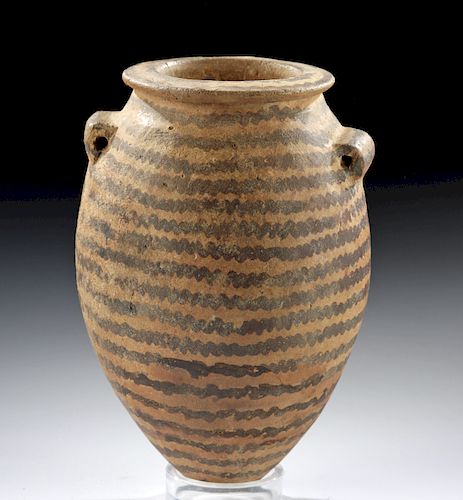Egyptian Pre-Dynastic Naqada II Terracotta Acorn Jar
Lot 2a
About Seller
Artemis Fine Arts
686 S Taylor Ave, Ste 106
Louisville, CO 80027
United States
Selling antiquities, ancient and ethnographic art online since 1993, Artemis Gallery specializes in Classical Antiquities (Egyptian, Greek, Roman, Near Eastern), Asian, Pre-Columbian, African / Tribal / Oceanographic art. Our extensive inventory includes pottery, stone, metal, wood, glass and textil...Read more
Estimate:
$4,000 - $6,000
Absentee vs Live bid
Two ways to bid:
- Leave a max absentee bid and the platform will bid on your behalf up to your maximum bid during the live auction.
- Bid live during the auction and your bids will be submitted real-time to the auctioneer.
Bid Increments
| Price | Bid Increment |
|---|---|
| $0 | $25 |
| $300 | $50 |
| $1,000 | $100 |
| $2,000 | $250 |
| $5,000 | $500 |
| $10,000 | $1,000 |
| $20,000 | $2,500 |
| $50,000 | $5,000 |
| $100,000 | $10,000 |
| $200,000 | $20,000 |
About Auction
By Artemis Fine Arts
Sep 26, 2019
Set Reminder
2019-09-26 10:00:00
2019-09-26 10:00:00
America/New_York
Bidsquare
Bidsquare : Exceptional Day 1: Antiquities & Asian Art
https://www.bidsquare.com/auctions/artemis-gallery/exceptional-day-1-antiquities-asian-art-4437
Day 1 of an important 2-day auction featuring exceptional, museum-worthy examples of Egyptian, Greek, Etruscan, Roman, Viking, Russian, Near Eastern, as well as Asian Art from China, Japan, Thailand, Vietnam, Burma and India. Artemis Fine Arts info@artemisgallery.com
Day 1 of an important 2-day auction featuring exceptional, museum-worthy examples of Egyptian, Greek, Etruscan, Roman, Viking, Russian, Near Eastern, as well as Asian Art from China, Japan, Thailand, Vietnam, Burma and India. Artemis Fine Arts info@artemisgallery.com
- Lot Description
Ancient Egypt, Predynastic Period, Naqada II, ca. 3500 to 3200 BCE. An incredible early example of Egyptian pottery, a buffware vessel in an elongated acorn form with a rounded body, a slightly corseted neck, a rolled rim, and a wide mouth. Two petite lugged handles are high on the sides. The body is painted with tightly packed, wavy lines that radiate horizontally around the circumference and, based on similar painted pottery from the region, likely represent waves on the Nile River. Many of the painted symbols on Naqada II vessels have been interpreted by researchers as having sacred symbolism, but there is no certainty without any written records. Lucite display stand for photography purposes only. Size: 3.75" W x 5.625" H (9.5 cm x 14.3 cm).
Although there is very little evidence pertaining to kilns that would lead to a better understanding of firing techniques from the Naqada II period, an interesting article written by Masahiro Baba analyzes the pottery produced at Hierakonpolis to propose a reconstruction of these techniques. Find this article entitled, "Pottery production at Hierakonpolis during the Naqada II period: Toward a reconstruction of the firing technique," British Museum Studies in Ancient Egypt and Sudan 13 (2009): 1-23.
For a stylistically similar example, please see The British Museum, museum number EA30888.
Provenance: private East Coast, USA collection; ex-Artemis Gallery; ex-private New Jersey, USA collection; ex-upstate New York, USA collection, 1950s
All items legal to buy/sell under U.S. Statute covering cultural patrimony Code 2600, CHAPTER 14, and are guaranteed to be as described or your money back.
A Certificate of Authenticity will accompany all winning bids.
We ship worldwide and handle all shipping in-house for your convenience.
#149806Repaired on lower area of one side, with resurfacing and light adhesive residue along break lines. Minor abrasions to body and rim, with light fading to original pigment. Nice earthen deposits throughout.Condition
- Shipping Info
-
All shipping is handled in-house for your convenience. Your invoice from Artemis Gallery will include shipping calculation instructions. If in doubt, please inquire BEFORE bidding for estimated shipping costs for individual items.
-
- Buyer's Premium



 EUR
EUR CAD
CAD AUD
AUD GBP
GBP MXN
MXN HKD
HKD CNY
CNY MYR
MYR SEK
SEK SGD
SGD CHF
CHF THB
THB
















